In the first section of a data analysis series looking at the best players in Asia, we’ll focus on centre-backs.
The leagues selected for this analysis are the following: Qatar Stars League, United Arab Emirates Pro League, Saudi Professional League, Japanese J1 League, South Korean K League and Chinese Super League. The Iranian Gulf Pro League would have been an interesting one to include but it lacks complete data on Wyscout and others like the Indian and Australian leagues missed out as their level is considered slightly lower. We have considered players whose main position was centre-back and who played at least 900 minutes in the aforementioned leagues in the last calendar year so the statistics are significant and representative.
The players marked with a star instead of a dot are those who made the final shortlist. We provide this information beforehand so readers can see how they performed and why they were selected as they read the data analysis.
Positioning and general defending
First and as an introduction, we’ll look at two very general defensive metrics. In the x-axis, we have successful defensive actions per 90, defined as the sum of defensive duels won, interceptions and sliding tackles normalized per 90 minutes; and on the y-axis, possession-adjusted interceptions, which helps us put the rest of the stats into context regarding the teams’ playing styles. The colour of the dots is the total number of interceptions so we know in which direction they were adjusted for possession.
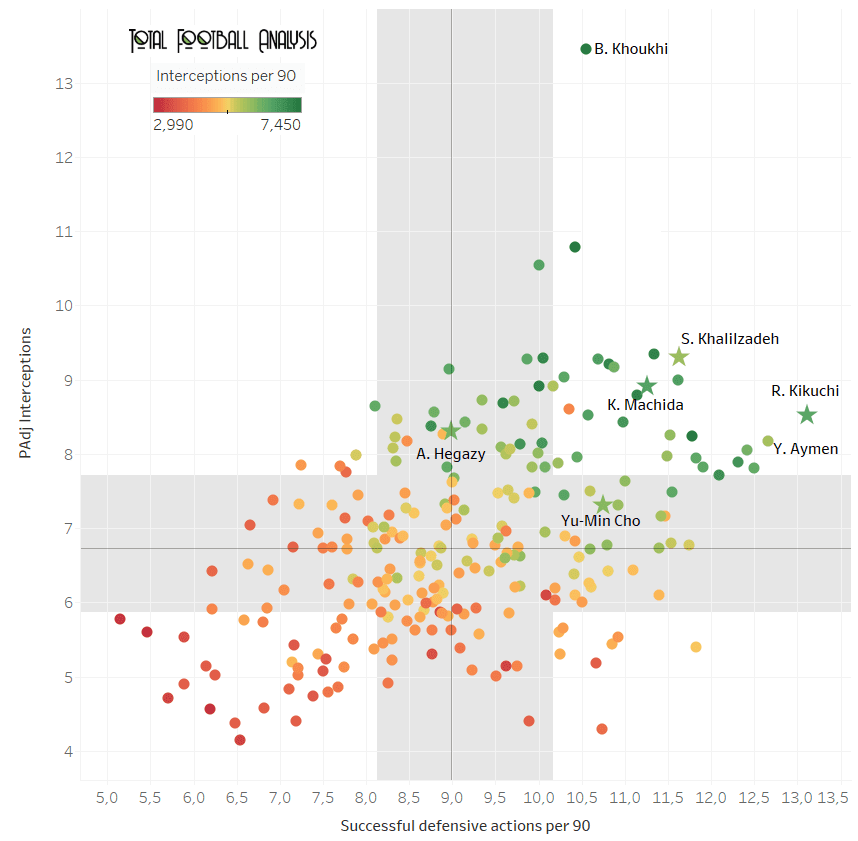
Boualem Khoukhi (31, Qatar) of Al Sadd SC stands out for his defensive positioning. His 7.45 interceptions per 90 playing for a possession-dominating team like Xavi’s Al Sadd become 13.45 possession-adjusted interceptions per 90, which is the best figure by far. Despite not having to defend too much in Xavi’s tactics, Khoukhi still ranks in the top quartile for successful defensive actions per 90, proving to be a good overall defender. Khoukhi was born in Algeria but moved to Qatar when he was just 18, playing first for Al Arabi (102 games, 27 goals) and from 2017 for Al Sadd (110 games, 14 goals), with whom he has won two leagues. He has 63 caps and 17 goals for Qatar and won the 2019 Asian Cup with them.
As a very busy and efficient defender, we find Ryuho Kikuchi (24, Japan) of VIssel Kobe, who’s also on our final shortlist. Kikuchi is the centre-back with the most successful defensive actions with 13.11 per 90 and is also among the best in interceptions with 6.51 per 90 (8.54 if possession-adjusted). Kikuchi started his professional career aged 22 after leaving the Osaka University of Health and Sport Sciences, joining Renofa Yamaguchi to play in the J2 League. In 2020, he joined Vissel Kobe in the J1 League and has played 55 games for them so far, lots of them alongside former Arsenal centre-back Thomas Vermaelen. Kikuchi doesn’t have any experience with the national team but his data suggests he should be considered soon.
Between Kikuchi and Khoukhi, we find Shoja Khalilzadeh (32, Iran) of Al Rayyan in Qatar. Khalilzadeh had 11.63 successful defensive actions and 5.89 interceptions (9.32 if possession adjusted) per 90, both among the best centre-backs in the considered leagues. After a very successful career in Iran in which he played over 215 games for Mes Rafsanjan, Sepahan, Tractor FC and Persepolis and won three leagues, one cup and three Supercups, Khalilzadeh joined Al Rayyan in the Qatar Stars League in 2020, having played 26 games since then. He’s been capped 17 times and has started the last 11 games for Iran. He’s also on our shortlist as we’ll see further down in the data analysis.
An interesting U23 option worth mentioning is Yousef Aymen (22, Qatar) of Qatar SC. Aymen is the centre-back with the second-most successful defensive actions per 90 with 12.66 and also ranks in the top 25% for possession-adjusted interceptions with 8.17 per 90 (5.78 without adjusting). Aymen is an ASPIRE Academy graduate who signed for Al Duhail but is currently on loan at Qatar SC. He was also loaned to ASPIRE’s satellite club KAS Eupen in the 2018/19 season but didn’t feature for the first team. Despite his limited experience of just 23 games in the Qatar Stars League, Aymen is a regular starter for Qatar U23 and one of the most promising defenders in the country.
The other three shortlisted players rank very differently here:
Ahmed Hegazy (30, Egypt) of Al Ittihad in Saudi Arabia doesn’t have a high volume of defensive actions and his 8.99 successful defensive actions per 90 are exactly the median of our sample, which is normal for a player in a possession-dominant team. Once we take into account possession, we can see he’s in the top quartile for possession-adjusted interceptions with 8.32 per 90 (6.18 if not adjusted by possession). Hegazy is very well known for his experience in the EPL and the Serie A and is one of the captains of Egypt (66 caps). Al Ittihad took their buying option from West Brom for 2.5 million euros last summer after his good performances in the Saudi Professional League.
Opposite to Hegazy, we find Yu-min Cho (24, South Korea) of Suwon FC in the K League 1. He has a high volume of successful defensive actions with 10.75 per 90 and despite having a good number of interceptions (6.04 per 90), he’s just above-average when adjusted for possession (7.32 per 90). Chi joined his current club after leaving Chung-Ang University in 2018 and has played 112 games since then (10 goals). He was part of the South Korea U23 squad that won the Asian Games in 2018 led by Heung-min Son so he received military privileges.
Finally, Koki Machida (24, Japan) of Kashima Antlers ranks very well here. He’s very close to the top both for possession-adjusted interceptions (8.93 per 90, 6.58 if not possession-adjusted) and successful defensive actions (11.26 per 90), showing he’s an intelligent and busy defender. Left-footed and standing at 1.90m, Machida has always played for Kashima Antlers (109 games, 8 goals), having won the J1 League and the AFC Champions League once. He’s part of the Japan U23 squad and participated in the Tokyo Olympics but hasn’t been called to the senior national team yet.
Defensive duels
Getting more specific, we’ll now look at defensive duels, defined as “when a player attempts to dispossess an opposition player to stop an attack progressing”. On the x-axis, we have the quantity and on the y-axis the success rate. The colour represents the total defensive duels won per 90 as a different way of visualizing the other metrics.
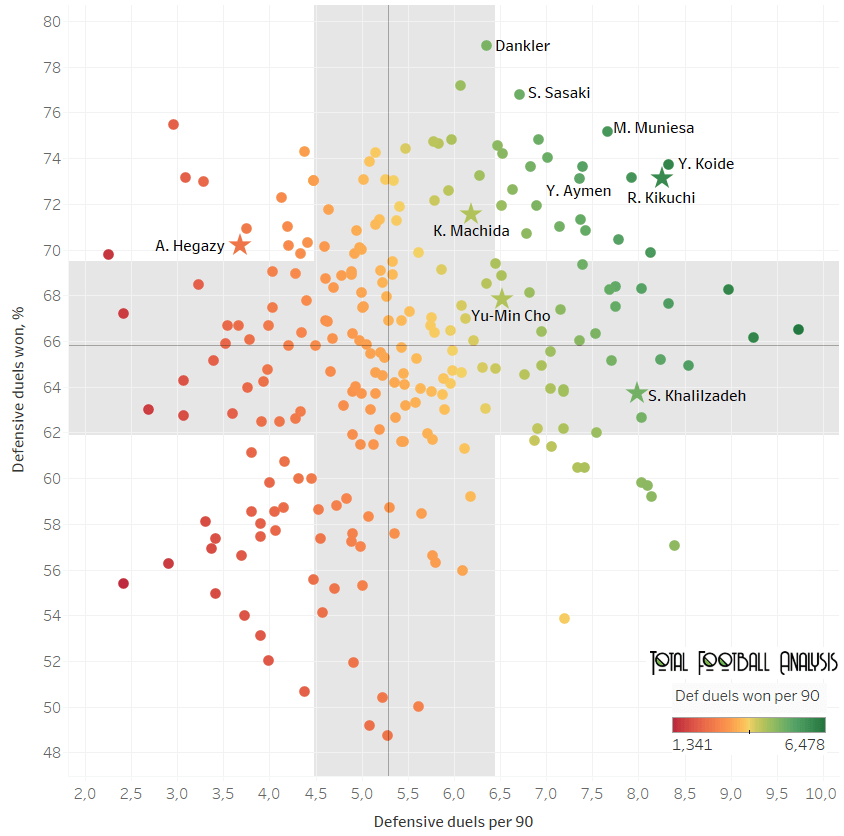
The first player we highlight here is Dankler (29, Brazil) of Al Ahli in Saudi Arabia since July after moving from Cerezo Osaka. Dankler is the most effective player in defensive duels, winning 78.95% of them. He also gets involved in an above-average number of duels (6.35 per 90), being just outside the top 25%. The 1.85m-tall centre-back has had a journeyman career, having played for EC Vitória, Botafogo and Joinville in Brazil before moving to Portugal to play for Estoril Praia and Vitória Setúbal (60 games in Portugal’s first division) with a loan to Lens in the Ligue 2 in the middle (11 games). He’s been playing in Asia since February 2019, first for Vissel Kobe and Cerezo Osaka in Japan (55 J1 League games) and since July for Al Ahli in Jeddah, Saudi Arabia (6 games so far). He won the Japanese Cup and Supercup with Vissel Kobe.
With more involvement than Dankler but less effectiveness, we find Sho Sasaki (32, Japan) of Sanfrecce Hiroshima. The small centre-back (1.76m) wins 76.78% (third-most) of his 6.71 defensive duels per 90 (top 25%). Sasaki started his career at Ventforet Kofu in 2012 after graduating from Kanagawa University, playing 119 games for them in the J1 and J2 Leagues. In 2015, he joined his current club and has played 181 games for them so far, becoming the captain and winning the league and the Supercup. Sasaki made his national team debut aged 28 in 2018 and has played and has been capped 14 times since then, becoming a regular player in the Japan squad.
Continuing with busier players who still dominate duels, we find Marc Muniesa (29, Spain) of Al Arabi in Qatar. Muniesa wins 75.18% of the 7.66 defensive duels he gets into per 90, both statistics among the best centre-backs in Asia. After a good career in Europe which saw him playing for Barcelona, Girona and Stoke City (34 games in La Liga, 60 in La Liga 2 and 57 in the EPL), Muniesa joined his current club in 2019 and has played 45 games for them so far. He was part of the Spanish youth national teams from U16 to U21 levels and even won the European U21 Championship in 2013 alongside De Gea, Thiago or Koke.
Next, we have Yuta Koide (26, Japan) of Oita Trinita. Koide is the player who gets into most defensive duels (8.33 per 90) among those who are in the top quartile for their success rate (73.72%), showing he’s good in ground duels both in quality and quantity despite being quite small (1.78m). Koide signed his first professional contract at Ventforet Kofu in 2017 after leaving Meiji University, playing 90 games for them (mostly in the J2 League) before joining his current club in January 2020. Since then, he has played 36 games (86% of them in the J1 League). He has never been part of the international setup and still needs to find consistent playing time because of injuries.
As the best U23 option, we find Yousef Aymen (22, Qatar) of Qatar SC again. Aymen wins 73.12% of his 7.36 defensive duels per 90, both close to the top. These statistics add to his good positioning to intercept the ball, highlighting him as a very interesting young prospect. ¡
Looking at our shortlisted players, we find very different data again:
Ryuho Kikuchi (24, Japan) of VIssel Kobe ranks very well in both metrics, winning 73.16% of his 8.25 defensive duels per 90. He’s the one who stands out here among the ones we’ve selected for our final list.
Koki Machida (24, Japan) of Kashima Antlers also wins a very good percentage of his defensive duels (71.6%) but his involvement is just above average (6.18 defensive duels per 90). With even less involvement because of his team’s tactics, we find Ahmed Hegazy (30, Egypt) of Al Ittihad, who wins 70.23% of his 3.68 defensive duels per 90.
In the group with more involvement but less success rate, we find Yu-min Cho (24, South Korea) of Suwon FC, who wins 67.9% (close to the top 25%) of his 6.52 defensive duels per 90 (top 25%). On the very busy but less effective side, we have Shoja Khalilzadeh (32, Iran) of Al Rayyan, who gets into a very good 7.98 defensive duels per 90 but wins a below-average 63.76% of them.
Aerial duels
Being dominant in the air is another key aspect for any centre-back. This time, we have the number of aerial duels per 90 in the x-axis and the success rate in the y-axis, with the colour representing the won aerial duels per 90 again.
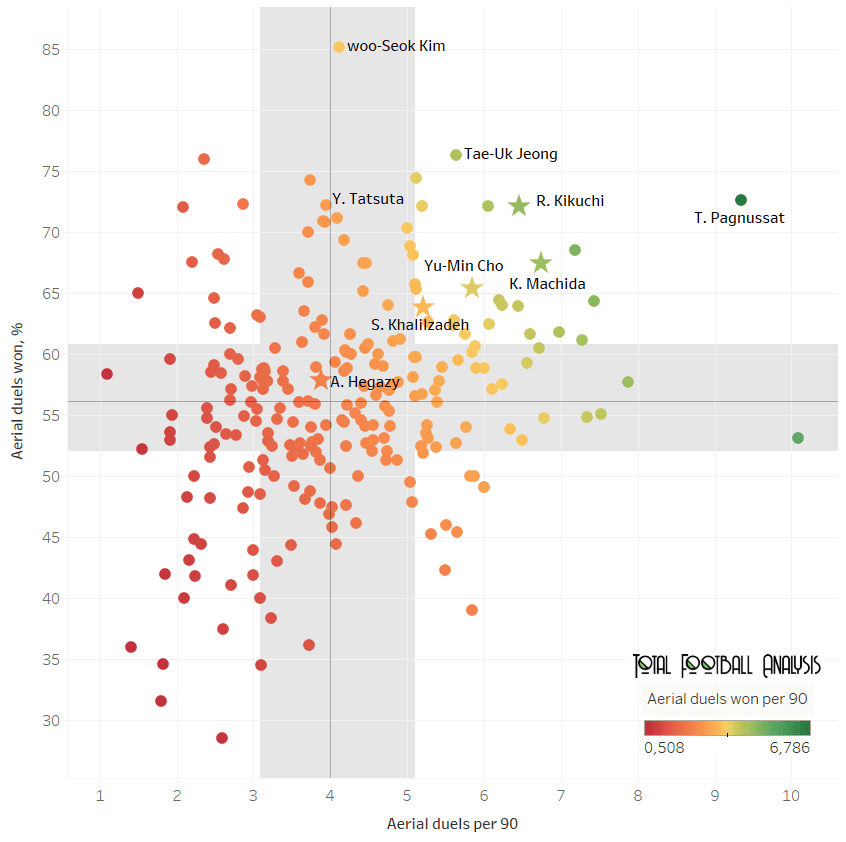
In this section of the data analysis, it makes sense to start with the player who wins the most aerials: Tiago Pagnussat (31, Brazil) of Cerezo Osaka. The towering centre-back (1.91m) wins 72.65% (sixth-most) of the 9.34 aerial duels he contests per 90 (second-most). Pagnussat, who also holds an Italian passport, joined his current team in April 2021 after spending most of his career in Brazil (280 games between the Serie D, C, B, A and different regional leagues and cups for Vila Aurora, Caxias, Atlético Mineiro, Bahía and Ceará) and a brief period in Argentina with Lanús (10 games). Since signing for Cerezo Osaka, he has played 25 games and scored 7 goals in all competitions, including 6 games and 3 goals in the AFC Champions League.
With much less involvement (just 4.11 aerial duels per 90) but an outstanding success rate of 85.11%, we find Woo-seok Kim (25, South Korea) of Daegu FC. Standing at 1.87m, Kim dominates in the air even if it would be interesting to see how he would perform if facing a higher number of challenges. Kim has always played for Daegu since leaving Shingal High School in 2016 and has appeared in 119 pro games so far. In the 2017/18 season, he won the South Korean Cup but has never featured for his country at any level.
In the middle ground appears Tae-uk Jeong (24, South Korea) of Daegu FC too. Standing at 1.94m, Jeong wins 76.3% (second-most) of his 5.63 aerials per 90. Jeong was part of the South Korea U23 squad that won the Asian Games in 2018 and has played 96 senior games for Jeju United and his current club since leaving Ajou University in 2016. He participated in the Tokyo Olympics and has been called to the senior South Korea team but hasn’t made his debut yet. He’s still quite young, especially considering how late Korean players start their senior careers so a move to Europe could be on the cards.
As the best U23, we highlighted Yugo Tatsuta (23, Japan) of Shimizu S-Pulse. Tatsuta, who stands at 1.91m, won 72.22% of his 3.94 aerial duels per 90. He has a single cap for Japan and plenty of experience with youth national teams from U20 to U23 groups. He has spent his whole club career at his current club, playing 124 games. At his age, he’s one to look at for a future move.
Most of our shortlisted players rank in the top quartile for both metrics in this section: Machida and Kikuchi are very good, winning 67.55% and 72.24% of their aerial duels (6.74 and 6.46 per 90) respectively. Cho and Khalilzadeh are also good with a success rate of 65.52% and 63.92% in their 5.84 and 5.2 aerials per 90 respectively. Hegazy looks worse here, winning a just above average 57.97% of his aerials and contesting just 3.88 per 90.
Progressive passes
Changing the focus to the on-the-ball contribution of the centre-backs, we’ll now see how good they are at progressing the ball. On the x-axis, we have progressive passes attempted per 90 and on the y-axis, the accuracy of those passes. The colour shows the total progressive passes completed per 90.
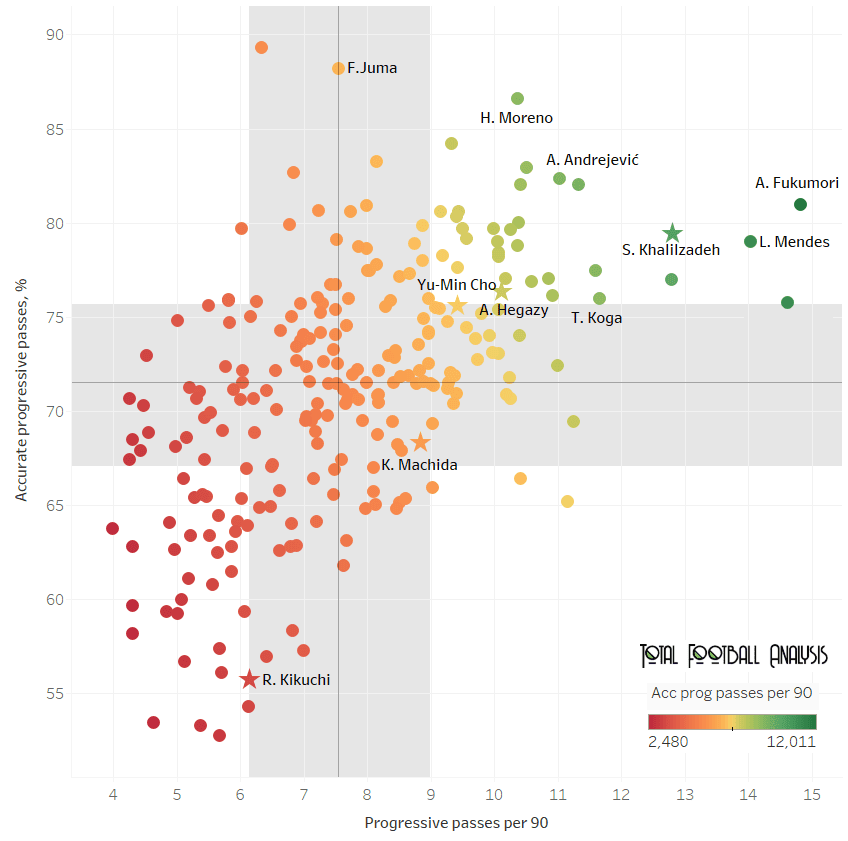
Akito Fukumori (28, Japan) of Hokkaido Consadole Sapporo stands out here as the player with the most accurate progressive passes per 90 (12.01). He’s the centre-back who attempts the most of them (14.83 per 90) and completes a very good 80.99% of them. Fukumori started his pro career at Kawasaki Frontale but played just 22 games in four seasons there before moving to his current team, where he has played 259 games (22 goals), first in the J2 League for two seasons and then in the J1 League. He doesn’t have any national team experience.
Close to Fukumori, we find Lucas Mendes (31, Brazil) of Al-Wakrah in Qatar. He completes 79.02% of the 14-03 progressive passes he attempts per 90 to a total of 11.09 accurate progressive passes per 90 (second-highest). Mendes started his career at Coritiba in Brazil, where he played 120 games in all competitions including Série B and A before moving to Olympique Marseille in 2012 for 2.3 million euros. In France, he played 62 games in two seasons before earning a 5-million-euros move to El-Jaish in Qatar. Since then, the left-footed centre-back has played a total of 159 games for El-Jaish, Al-Duhail, Al-Gharafa and Al-Wakrah, all in Qatar, winning Qatar Stars League once.
Looking at those centre-backs with a greater progressive passing accuracy, we find Fares Juma (32, UAE) of Al Wahda. He completes 88.17% (second-most) of his average 7.54 progressive passes per 90. Juma has always played in the United Arab Emirates, starting at Al Ain and then playing for Al Jazira and Al Wahda for a total of 218 club games. He has won the UAE Pro League twice with Al Ain and Al Jazira and finished fourth in the 2017 Club World Cup with Al Jazira, playing 90 minutes in the semifinals against Real Madrid.
As a more balanced option, we have Héctor Moreno (33, Mexico) but he signed for Monterrey in July 2021 after a good season at Al Gharafa in Qatar so we have chosen Aleksandar Andrejevic (29, Serbia) of Gwangju FC in South Korea, who completed 82.33% of the 11.03 progressive passes per 90. After a quite average career in Serbia (Proleter Novi Sad, Donji Srem Pećinci and Cukaricki – 64 games in the first division and 74 in the second) and Czech Republic (11 games for 1.FK Pribram in the first division), Andrejevic moved to South Korea in February 2021 and has hit the ground running since then, playing 24 games so far. He has played one game for Serbia in January but hasn’t been called to the national team since then.
The best U23 here is Taiyo Koga (22, Japan) of Kashiwa Reysol. He is among the players who attempt the most progressive passes with 11.65 per 90 and still in the top 25% for completion with 75.96%. Koga came through the academy at the club and has been there all his career so far except for a loan at Avispa Fukuoka. In total, he has played 72 games in the J1 League and 58 in the J2 League, plus another 23 in national and international cups. He’s been part of the Japan youth setup from the U19 to the U23 age groups and made his debut for the senior national team in 2019 too, so he’s highly rated at his national team.
Among our shortlisted players, we find different profiles:
Khalilzadeh is one of the best players here, completing 79.5% of the 12.8 progressive passes he attempts per 90. Hegazy is also in the top quartile for both statistics, attempting 10.11 progressive passes per 90 with an accuracy of 76.39%. Cho is also quite good with 9.42 progressive passes attempted per 90 (top 25%) and just out of the best quartile in accuracy with 75.64%.
Machida is just average, attempting above-average progressive passes (8.84 per 90) but completing a below-average 68.39% of them. Finally, Kikuchi is quite bad at progressing from the back, attempting just 6.14 progressive passes per 90 and completing 55.79% of them, the fifth-worst percentage.
Directness on the ball
For this section, we’ve created two metrics. In the y-axis, we have forward passes every 100 passes, trying to measure how often they try to play the ball forward. In the x-axis, progressive passes every 100 passes, looking at how often the forward pass successfully looks to advance the team significantly closer to the opponent’s goal.
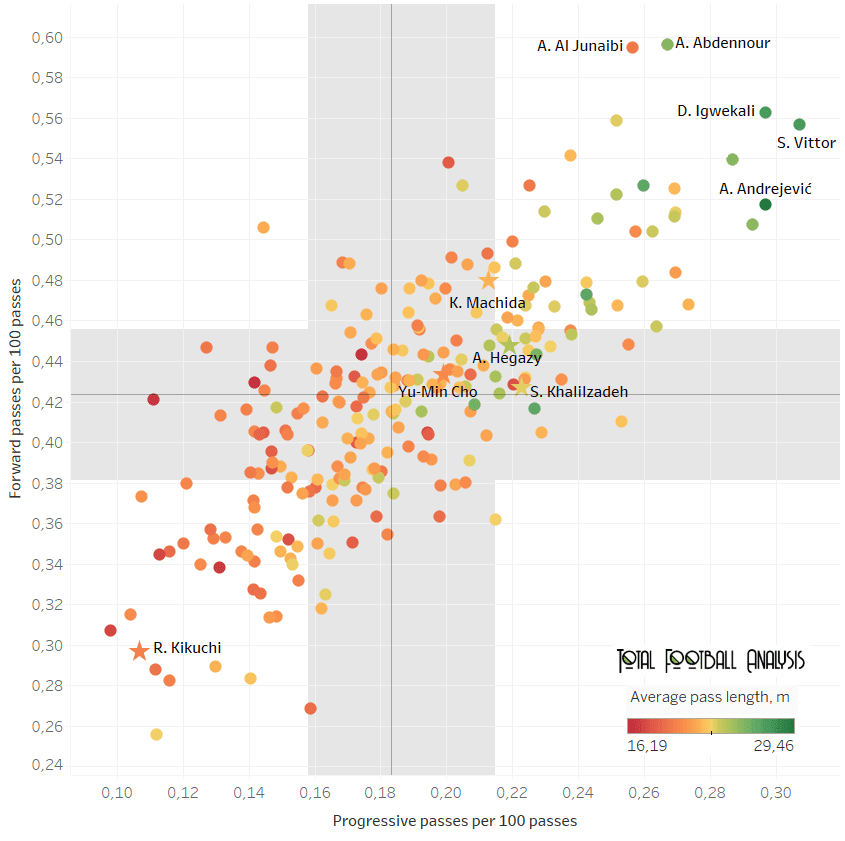
Sergio Vittor (32, Argentina) of Damac FC in Saudi Arabia is the player who stands out the most here. Progressive passes represent 30.71% of his total passes, more than anyone else in this analysis, and 55.65% of his passes are forward passes too, which is very close to the top. Considering this, it’s normal that his average pass length of 27.43m is also very close to the top. Before signing for his current club in January 2020, Vittor had played all his career in South America (mostly in Argentina) except for a six-month loan to MSK Zilina in Slovakia (8 games). He played 155 games in the Argentinian Primera División and 43 in the second division apart from 13 in continental competitions and 9 in the domestic cup for the likes of Independiente, Gimnasia y Esgrima de La Plata, Gimnasia y Esgrima de Jujuy, Argentinos Juniors, Atlético Rafaela, Banfield and Racing Club. He also had a couple of loans in Chile at Universidad Concepción and Universidad de Chile, playing 34 games there. Since he arrived in Saudi Arabia, he has played 51 games.
Another very direct player is Aleksandar Andrejevic (29, Serbia) of Gwangju FC, who naturally stood up in progressive passes too. Andrejevic’s progressive passes represent 29.68% of his total passes and his forward passes, 51.72%. With the highest passing length in our sample (29.46m), he’s one of the most direct centre-backs.
Another one that looks very good is Aymen Abdennour (32, Tunisia) of Umm Salal SC in Qatar. He has the highest forward pass ratio with 59.61% and 26.71% of the passes he attempts are progressive passes too, leading to a high average pass length of 25.33m. Abdennour started his career at ES Sahel in his home country before playing for Werder Bremen, Toulouse, Monaco, Valencia, Marseille and Kayserispor. He has played 150 games between Ligue 1, La Liga and Bundesliga and also has continental experience in Europe and Africa. Between 2009 and 2019 he played for Tunisia and was capped 58 times.
Close to Abdennour, we find Abdalla Saleh Al Junaibi (33, United Arab Emirates) of Ajman Club in the UAE Pro League. He’s the centre-back who plays the second-most forward passes (59.46% of his passes) and also stands out with 25.65% of his passes being progressive. What changes from Al Junaibi compared to the rest of the players is that his average passing length is very low (just 19.58m), meaning he breaks lines with shorter passes instead of launching long balls or line-breaking passes from very deep. Saleh has always played in the UAE for Al Shaab, Al Wasl, Al Fujairah and since 2020 for Ajman Club. In total, he has 171 UAE Pro League and 8 AFC Champions League games but has never won a title or been part of the UAE national team.
Our U23 highlighted player here is Darlington Emmanuel Igwekali (21, Nigeria) of Al Fujairah in the UAE. He’s one of the best players in this section of the data analysis with 56.26% of his passes being forward passes (third-most) and 29.69%, progressive passes (second-most). His average pass length of 27.3m is also well above average. Igwekali left Nigeria very young to join Alanyaspor in Turkey but only appeared 8 times for their U21 team before moving to Olimpik Donetsk II, where he couldn’t find playing time. After more than one year as a free agent and in the middle of the pandemics, he signed for Ajman Club in 2020, playing 17 games in his first season signing for his current club in September 2021. He hasn’t featured for his country at any level yet.
Looking at our shortlisted players, none of them really stands out but they behave differently:
Hegazy and Khalilzadeh are in the top 25% for their progressive pass ratio (21.93% and 22.29% respectively) but fall into the second quartile in the forward pass ratio (44.83% and 42.73% respectively). Both of them seem to play for possession-dominant teams so it’s normal they aren’t as direct because their teams value possession a lot.
Machida also looks good, being in the top quartile for forward passes (48.04%) and close to the top 25% for progressive passes (21.29%). Cho is just above average in both statistics with 43.38% of his passes being forward passes and 19.9%, progressive passes. Kikuchi again looks bad on the ball with just 29.71% of his passes being forward passes and 10.69%, progressive passes.
Goal scoring
Even if not a defender’s main task, it’s always good for any team to add some goals from the centre-backs. Here we’ll have a quick look at non-penalty goals per 90 (y-axis) and non-penalty xG per 90 (x-axis), with the colour showing shots per 90.
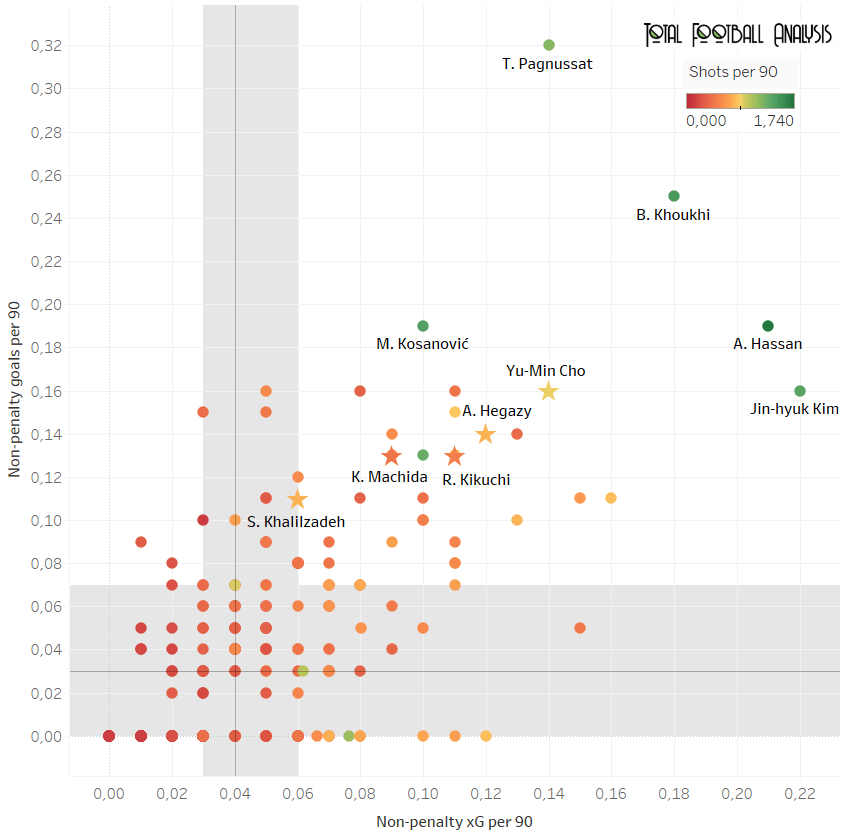
The clear standout player here is Tiago Pagnussat (31, Brazil) of Cerezo Osaka, who also stood out as one of the best centre-backs in the air. Pagnussat has scored 0.32 goals from 0.14 xG and 1.2 shots per 90 in the last year. His aerial power makes a difference at both ends of the pitch.
Boualem Khoukhi (31, Qatar) of Al Sadd, who was one of the best players in terms of defensive positioning, also appears here. With 0.25 goals from 0.18 xG and 1.47 shots per 90, he’s a real goal threat and can win games in attack too.
Abdelkarim Hassan (28, Qatar) of Al Sadd and Milos Kosanovic (31, Serbia) of Al Jazira scored at the same similar rate of 0.19 goals per 90 but their finishing was far away in quality. Hassan scored that from 0.21 xG (second-most) and 1.74 shots (highest) per 90, while Kosanovic did it from just 0.1 xG and 1.41 shots per 90.
Hassan is one of the best Qatari players right now. He came through the ASPIRE Academy before joining Al Sadd, where he has played almost all his career (236 games and 30 goals) except for a brief loan at KAS Eupen (11 games). With Al Sadd, he has won the Emir of Qatar Cup and the league three times and the AF Champions League in 2011. He was elected Player of the Year in the 2017/18 season. With Qatar, he has been capped 85 times (11 goals) and won the Asian Cup in 2019.
Kosanovic came through the academy at Vojvodina but started his senior career at FK Mladost Apatin in the Serbian second division (42 games). From there, he moved to Cracovia in Poland, playing 88 games (10 goals) in 3.5 seasons before going to Belgium to play for Mechelen first and then Standard Liège (141 games in total). He also had a loan at Göztepe in Turkey (23 games) and since 2020 he’s playing for Al Jazira, where he has had 50 appearances and 7 goals so far. Kosanovic played just one time with Serbia and won the Belgian Cup with Standard Liège and the UAE Pro League last season.
Here, we can also mention Jin-hyuk Kim (28, South Korea) of Daegu, who has the highest xG per 90 (0.22 per 90) but only scored 0.16 goals per 90. Kim has been with his current club since he joined from Soongsil University, featuring 118 times for them (20 goals), becoming the captain of the club and winning the 2017/18 South Korean Cup. He also had loans at Ulsan Hyundai Mipo Dolphin and Gimcheon Sangmu, taking his total senior appearances at club level to 152. He also played three times for South Korea U21 but never progressed from there.
All of our shortlisted players fall in the top quartile in this section of the data analysis:
Cho scored 0.16 goals from 0.14 xG per 90; Hegazy 0.14 from 0.12; Kikuchi 0.13 from 0.11; Machida 0.13 from 0.09; and Khalilzadeh 0.11 from 0.06. All of them contribute to winning games in the opposition box which is always valuable in a centre-back.
Shortlist
In the graph below, we show the strengths and weaknesses of the shortlisted centre-backs. Dark green means they are in the top quartile for the given metric, light green in the second, light red in the third and dark red in the last one. This is a way of quickly visualizing where they excel.

Shoja Khalilzadeh (32, Iran) of Al Rayyan (Qatar Stars League). Khalilzadeh comes out of this analysis as an almost flawless centre-back from a data point of view. He’s in the top quartile for every metric we considered, both defensive and offensive, except his success rate in defensive duels, which is between the 75th and the 50th percentiles. The Iranian is a very busy defender with excellent positioning, great in the air and with a lot of quality and willingness to progress the ball apart from being a goal threat.
At his age, the normal thing would be for him to finish his career at a similar level as he’s at now but he still has two or three seasons left at his peak and would be an amazing signing for clubs in Qatar or similar leagues. His experience and quality would make him an interesting short-term bet for teams in secondary leagues in Europe or the MLS too.
Yu-min Cho (24, South Korea) of Suwon FC (South Korean K League 1). Cho is the most balanced option in this shortlist. He’s among the best 25% centre-backs in our analysis for all statistics except possession-adjusted interceptions, defensive duels success, progressive pass accuracy and directness, sitting between the 25th and the 50th percentiles in those. A very busy defender with good positioning, great in the air and good in defensive duels, he also has a high volume of progressive passes and poses a goal threat.
Aged just 24, Cho is entering his peak years and could be a very interesting target for clubs in Europe. South Korean players usually start their careers slower than other nationalities given they often go to University first so they shouldn’t be compared to players of his age but to those who have similar senior experience. Having avoided military services after winning the Asian Games is another big positive in him.
Koki Machida (24, Japan) of Kashima Antlers (Japanese J1 League). Machida is an excellent defender, appearing in the top quartile for every defensive metric except defensive duels per 90, in which he’s in the second quartile. He’s also good on the ball as he’s quite direct and has a good volume of progressive passes (both in the second quartile) even if his accuracy is just ok (third quartile). Like the rest of the shortlisted players, he’s capable of scoring too.
Like Cho, Machida is also 24 and quite young for a centre-back and Japanese players also tend to move abroad later in their careers. He has great examples to follow like Maya Yoshida (ex Southampton and current Sampdoria player) or, more recently, Takehiro Tomiyasu of Arsenal.
Ahmed Hegazy (30, Egypt) of Al Ittihad (Saudi Professional League). Hegazy is excellent on the ball, being in the top quartile for directness, progressive passes volume and accuracy and scoring. In defence, he’s a different profile as he plays for a dominating team and has low involvement. He’s in the bottom quartile for defensive duels per 90 and in the third quartile for aerials per 90 but he still wins most of his defensive duels (top quartile) and lots of aerials (second quartile), and his high possession-adjusted interceptions prove he’s an intelligent defender too.
With a lot of experience in the Premier League and the Serie A, Hegazy is still at his peak and has some good years left in his career so he could be an interesting one for a team looking for an experienced leader for their defence. His high salary surely means he would only leave Saudi Arabia for one of the top-5 leagues in Europe, which makes it more difficult to think about him as a future option for second-level teams.
Ryuho Kikuchi (24, Japan) of VIssel Kobe (Japanese J1 League). Kikuchi is an old-school centre-back who excels in every defensive metric. His size of XXX also means he’s a goal threat but he looks bad in the rest of the attacking metrics, appearing in the last quartile for directness and progressive passes accuracy and in the third quartile for progressive passes attempted per 90.
Nowadays, centre-backs are expected to do a lot more than defending, which is making pure defenders a rarer and rarer commodity. At 24, Kikuchi has already proven he can lead a defensive line in a good league like the Japanese and surely deserves a move to Europe or a higher level competition soon. Any team who decides to get him would get a no-nonsense defender who could pair very well with a ball-playing centre-back.
Conclusion
With football becoming more and more global in recent years, it isn’t strange to see Asian players at the highest level in Europe. Looking at Asia is now a very interesting option to find unexploited talent and some teams are already doing it with great success.
Sint-Truidense VV in Belgium are one of the teams that have excelled in the Asian market, specifically in Japan, with the likes of Daichi Kamada (Eintracht Frankfurt), Takehiro Tomiyasu (Arsenal) or Wataru Endo (Stuttgart) among others having featured for them recently.
With some data analysis that provides a list of interesting players to watch, clubs can focus their video/live scouting efforts on those that fit their requirements, saving time and resources to scan a market as big as the Asian.





Comments